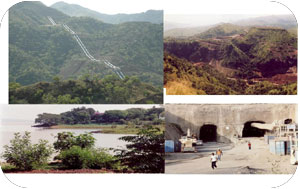 |
|
|
|
|
 |
||||||||||||||||||||||||||||||||||||||||||||||||||||||||||||||||||||||||||||||||||||||||||||||||||||||||||||||||||||||||||||||||||||||||||||||||||||||||||||||||||||||||||||||||||||||||||||||||||||||||||||||||||||||||||||||||||||||||||||||||||||||||||||||||||||||||||||||||||||||||||||||||||||||||||||||||||
The Ethiopian Electric Power Corporation as public enterprise was established for indefinite duration by regulation No. 18/1997, and conferred with the powers and duties of the previous Ethiopian Electric Light and Power Authority. The purpose of the corporation is to engage in the business of producing, transmitting, distributing and selling electrical energy (in accordance with economic and social development policies and priorities of the government) and to carry on any other related activities that would enable it achieve its purpose. It was determined by the establishment regulation that the corporation shall have its Head Office in Addis Ababa and may have branch offices elsewhere, as may be necessary. Access to Electricity, Housing Conditions and Possession of Household AssetsAccess to electricity can make real difference to the livelihood of people. Although electricity alone will not reduce poverty, the lack of access to this modern energy is a severe constraint to development. Improving access to electricity is thus essential for poverty reduction and its ultimate eradication. To reduce the level of poverty one should enhance income generating means and bring change in quality of life of people. The ultimate objective of electrification should thus be provision of electricity to a large number of rural town and village dwellers on sustainable basis, and to support income generating activities. To enhance income generating capacity means provision of electric energy for driving electric motors necessary for small scale manufacturing, pump sets for irrigation, motors for mills, etc. The on-going Universal Electricity Access Program (UEAP) has been launched by the Government of Federal Democratic Republic of Ethiopia to meet the demand of agricultural sector (irrigation pumps, prevention of farm products, etc.), industrial and commercial sector, rural water supply installations, residential consumptions, education and health sectors. The program, while expected to broadening the national electrification coverage and increasing people’s access to electricity from 16 percent to 50 percent within the period 2004/05 – 2010/11, will underpin the ADLI strategy and poverty reduction strategy of the government. In other words, the program will play a crucial role in helping to achieve the Millennium Development Goals. During the first three years of implementing Ethiopia’s Five-Year Development Plan (PASDEP) spanning the period 2005/06-2009/10, access to electricity increased from 16 percent in 2004/05 to 33 percent by the end of 2007/08. Alongside the expansion of access, equity of electrification among the regional states of the country is also a key agenda of the Government of Ethiopia. Table 6.20 -below depicts hither to achievements in distribution of access to electricity regional states and City Administrations in Ethiopia. Table 6.20: Regional Distribution of Access to Electricity
At the beginning of the program 7,542 towns and villages were identified. Out of these towns and villages only 787 were electrified. Up to the fourth year of the Plan, 3,367 towns and villages are coming in to the system. This shows that the three years accomplishment is 278% much more than what has been achieved in 50 years. As has been stated elsewhere in this Report, agriculture is the mainstay of the Ethiopian economy. Out of the total population of the Country, 80% of lives in rural areas, where 50% of them are women and around 20% of the rural land owners are households headed by women. Moreover, the wives in the male-headed households do participate in every agricultural activity in addition to their day-to-day house work and child caring (CSA). Therefore in order to make a meaningful improvement in the agricultural sector of this country, the Government strives towards reducing the burden of women. Non-electrified households are poorer than electrified ones in many ways: lower level of education, more self employed, fewer small businesses at home, less access to loans banks or cooperatives, living far from the main road, a very small houses more often made with traditional construction materials, more likely to get drinking water from unprotected wells or springs and having significantly fewer durable goods. The active length of day is slightly longer especially for men-when electricity is available at home. Women gain by saving time instead of making unnecessary travel and their tasks will be made easier with electric appliances. Village electrification also changes the day-to-day life of the poorest households who remain unconnected to the grid. Safety is enhanced: people will be able to move around the village in the evenings, go to school, visit friends, participate in social meetings and visit local shops. Such households also greatly appreciate the extension of local health services: they no longer have to travel to the nearest city to buy vaccinations and medication. All school children benefit from improved school services. This programme could not be successful unless consultation is made at the different hierarchical level of administration and the public at large. Accordingly, proper consultation has started at the grass-root level for the various future work of the project. In all this national effort to increase access to electricity, the generation technology has been based on the least cost criteria, which results in a ranking of small and larger hydropower plants as well as environmentally sound approaches, in combination with an optimum generation mix of some wind and Geothermal sources in a least cost development programme. In some cases, the programme also involved small- localized off grid power sources (such as photovoltaic solar and mini hydro). During 2006/07, through the Universal Electricity Access Programme (UEAP), it was planned to connect 869 towns and villages located across the country and 758 of them were connected. This brings the number of towns and villages with access to electricity to 1,620. Accordingly, total electricity coverage of the country has increased to 33 percent from just 16 percent in 2004/05. Further, some of the activities currently undertaken include: Ethiopia is endowed with huge water potential i.e. more than 45,000 MW whose development in large scale might have eliminated the energy shortfall and become source of foreign currency generation. To supplement the very cheap hydro power development the use of alternative energy resources has also focused. It is also estimated that Ethiopia has a potential of generating 10,000 MW from wind and around 5,000 MW from Geothermal. From all this potential Ethiopia exploited only 1.4%. With in the third strategic plan year (2004/05 – 20010/11) 3,290 MW capacity power plants are under construction. Out of this two hydro power plants having a total capacity of 720 MW are completed. This makes the total capacity of the corporation 1534MW and increased the total system capacity by 47%.
Power Transmission and substation infrastructure development is one of the basic elements in power sector infrastructure. The transmission lines of the power sector can be interconnection with other countries and the expansion of the in house requirement. The expansions of the transmission lines are intended to ensure supply of reliable & efficient electric power with minimum loss, to facilitate universal electricity access program. In the case of interconnection with other countries can have the following opportunities:-
Various power system interconnection activities have been initiated with neighboring countries
Unit energy cost of Hydro generation projects -Committed &Candidate
New Hydro Under study
Wind generation projects - Committed
Geothermal generation projects - Committed
Additional Transmission Capacities which will come in future
|
Tekezeme Dam
Hydro plants under construction
On going projects – Gilgel Gibe II & Beles |
||||||||||||||||||||||||||||||||||||||||||||||||||||||||||||||||||||||||||||||||||||||||||||||||||||||||||||||||||||||||||||||||||||||||||||||||||||||||||||||||||||||||||||||||||||||||||||||||||||||||||||||||||||||||||||||||||||||||||||||||||||||||||||||||||||||||||||||||||||||||||||||||||||||||||||||||||
|
|
|
Make World Investment News Your Homepage. |


















